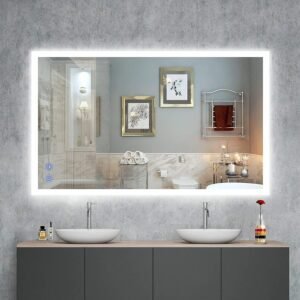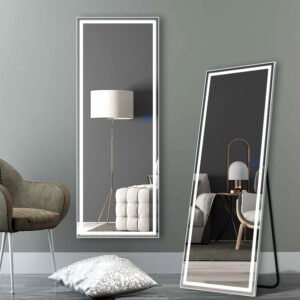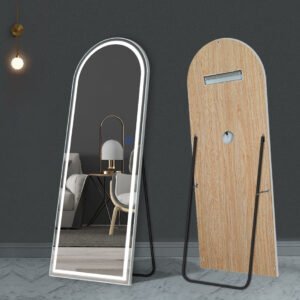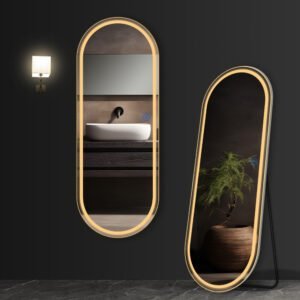Many mirrors do not provide adequate illumination, making operations like cosmetics and shaving difficult. LED mirrors alleviate this problem by providing bright, even illumination and smart features that enhance both convenience and attractiveness. So how do lighted mirrors work?
Miroirs éclairés work by using built-in LED strips to provide uniform lighting. These mirrors often feature touch controls, dimmable settings, and even motion sensors. With energy-efficient LED technology, they offer long-lasting brightness while consuming minimal power, making them ideal for grooming, makeup, and modern home décor.
Let’s explore the key components, uses, and advantages of lit mirrors, as well as practical aspects like installation and energy efficiency.

Table des matières
BasculerWhat Are the Main Components of a Lighted Mirror?
The effectiveness and performance of an illuminated mirror are determined by its components, which include durability and illumination quality. The major components are the mirror, the LED lighting system, and the power supply.
A typical lit mirror has a high-definition silver mirror, energy-efficient LED lights, a power driver, and a control system such as touch or smart controls. These components work together to deliver the best performance, durabilité, and user convenience.
When choosing an miroir illuminé, it is critical to grasp its basic components. First and foremost, the high-definition silver mirror acts as a reflecting surface. This material provides clarity, giving consumers a distortion-free view, which is especially useful while applying cosmetics or shaving.
The LED lights placed around or behind the mirror serve as the major source of lighting. These LED strips are available in a variety of quality and configurations, such as backlit mirrors or front-lit mirrors, to provide even and shadow-free illumination. The location of the lights determines how the light reflects and illuminates the user’s face.
The power driver is in charge of managing the LED lighting system, ensuring that the LEDs receive the appropriate voltage and perform properly. This component is generally low-power, which improves the energy efficiency of Miroirs LED.
Enfin, control systems such as touch sensors, motion detectors, or even smart controls make it easier for users to operate the mirror. Depending on the model, you may adjust the brightness, color temperature, and even turn on/off the mirror without using physical controls.

How Does the Lighting System in a LED Mirror Work?
The lighting mechanism of an LED mirror is critical to its operation and use. Understanding how it works will help people get the most out of their mirrors. Most LED mirrors run on low-voltage DC electricity. The LED strips are positioned around or behind the mirror to provide steady, shadow-free lighting, and some models have changeable color temperatures.
An LED mirror’s lighting system is supplied by a low-voltage DC power supply, which is more energy efficient than standard incandescent lights. This power system saves electricity while providing adequate lighting for grooming, cosmetics, and daily activities.
Depending on the type of mirror, LED strips are positioned around its perimeter or behind it. Backlit mirrors emit a gentle, ambient glow around the borders, but front-lit mirrors give a more concentrated light source that directly illuminates the user’s face. The lighting from these strips is frequently designed to simulate natural daylight, producing strong, even illumination that reduces shadows.
One of the primary benefits of LED lighting is its adaptability. Many versions have dimmable settings, which let users to adjust the brightness according to their tastes. En outre, some LED mirrors have adjustable color temperatures, ranging from warm yellow to cool white light. This function is especially beneficial for makeup application, as changing lighting conditions can alter the look of makeup colors.
Certain Miroirs LED have motion sensors and touch sensors for enhanced convenience. These capabilities allow users to turn on and off the mirror without using a switch, giving another layer of usefulness to the mirror. Some smart mirrors even have Bluetooth connectivity, allowing you to manage the lighting settings via an app or voice commands.

What Are the Benefits of Using a Lighted Mirror?
Compared to traditional mirrors, LED mirrors provide better vision, energy economy, and modern features that simplify everyday routines. Even illumination, energy economy, capacités anti-buée, adjustable brightness, and smart technologies like as Bluetooth and motion sensors are all significant advantages.
There are various advantages to using lighted mirrors in both personal and business environments. First and foremost, these mirrors produce uniform illumination, which is critical for precise chores like cosmetics application, shaving, and grooming. Contrairement aux miroirs traditionnels, which can cast shadows and cause uneven illumination, LED mirrors provide steady brightness, removing dark patches and improving vision.
LED mirrors have another big advantage: they are energy efficient. LED technology utilizes a fraction of the energy of typical incandescent lights, lowering your electricity expenditure. En outre, LED lights last far longer—up to 50,000 hours—so you won’t have to change bulbs as often.
Many LED mirrors have anti-fog technology for individuals seeking the best grooming conditions. This function keeps the mirror from anti-fog technology, even in humid places such as toilets. It’s especially useful when you’re in a hurry or want a clean reflection after a shower.
Adjustable brightness and color temperature adjustments are necessary for makeup mirrors with lights. Users of a touch sensor mirror light may fine-tune the illumination to fit their needs, whether they desire warm lighting for a homey look or bright, cold lighting for precise tasks.
Some smart mirrors also support Bluetooth, allowing you to link your phone or other devices to the mirror. This function allows you to play music, get notifications, and even make hands-free calls while grooming or getting dressed.

Are Lighted Mirrors Energy-Efficient?
Many consumers worry if LED mirrors use a lot more power than conventional lights. LED mirrors employ low-power LED strips that consume around 80% less energy than incandescent lamps. They have a lifetime of up to 50,000 heures, which lowers replacement expenses.
One of the most notable aspects of LED mirrors is their energy efficiency. Traditional incandescent lights are infamous for their excessive energy consumption, while LED lighting consumes far less power—up to 80% less. This makes LED mirrors an affordable and ecologically responsible option for both individuals and businesses.
In addition to being low-energy, LED lights offer a substantially longer lifespan than traditional bulbs. LED mirrors may last up to 50,000 hours on average, ensuring dependable lighting for more than ten years of everyday usage. This lifespan significantly decreases the frequency and expense of replacements, resulting in long-term savings.
LED mirrors are also available in a variety of power levels to meet different requirements. Battery-powered LED mirrors, Par exemple, provide versatility for users who may not have access to an electrical outlet or prefer a wire-free option. Hardwired LED mirrors are an excellent choice for permanent installations, since they provide continuous power without the need for battery replacements.

How to Install a Lighted Mirror?
Proper installation assures safety and extends the mirror’s life and performance. Most LED mirrors must be wall mounted using hooks or brackets and connected to a power supply. Some types connect to an outlet, while others are hardwired.
Installing an LED mirror may appear difficult, but with the proper equipment and planning, it is a simple operation. D'abord, identify the mirror’s position and make sure the wall can sustain its weight. Most LED mirrors are attached using wall brackets or hooks that secure the mirror in place.
Battery-powered Miroirs LED are simple to install since they do not require hardwiring. These mirrors frequently come with an installation guide to assist you fasten them to the wall. Once installed, you can quickly change the batteries as needed, ensuring that your mirror stays functioning.
If you choose a hardwired LED mirror, the process is little more complicated. In this scenario, you’ll need to connect the mirror to the electrical system, making sure the cabling is done correctly to avoid any risks. If you’re not familiar with electrical work, you should engage a professional electrician to guarantee a safe and secure installation.
Safety is crucial, especially in damp locations such as bathrooms, so ensure that the mirror is waterproof and that the wiring is securely sealed to avoid electrical problems.

Do Lighted Mirrors Provide Enough Light?
Some users are concerned that LED mirrors may not provide adequate illumination for chores such as shaving or applying cosmetics. High-quality LED mirrors emit bright, evenly dispersed light that closely resembles natural daylight, making them excellent for grooming and cosmetics. The option to adjust the brightness further improves usefulness.
One of the most common worries individuals have when purchasing an LED mirror is whether it delivers enough light. The answer is often yes—high-quality LED mirrors provide brilliant, evenly distributed illumination ideal for operations such as cosmetic application, shaving, and grooming.
LED lights can create strong, constant lighting without casting shadows, which is extremely useful for cosmetic mirrors with lights or makeup mirrors with LED lights. They replicate natural lighting, allowing you to see colors more clearly and avoiding makeup from seeming too dark or uneven.
Most LED mirrors have adjustable brightness levels, allowing users to tailor the degree of light to their needs. Whether you need a subtle glow for leisure or intense lighting for precise activities, the mirror’s touch sensor and smart controls make it simple to customize.
En outre, certain backlit mirrors emit a softer ambient light, which may be more pleasant in low-light environments. D'autre part, frontlit mirrors provide direct lighting, making them perfect for intricate work.

Do LED Mirrors Need to Be Plugged In?
Understanding the power needs of an LED mirror is critical for its correct installation and operation. Most LED mirrors must be hooked into an electrical outlet, although some versions provide direct wall connection for a cleaner appearance.
When selecting an LED mirror, it is crucial to examine how it will be powered. Most LED mirrors with lights must be hooked into a power outlet. This maintains a steady power source, allowing the lights to operate without interruption.
Cependant, there are certain battery-powered LED mirrors available, which are ideal for customers who desire a wire-free environment. These mirrors use rechargeable or changeable batteries, allowing them to be used anywhere without the need for an electrical outlet.
Hardwired LED mirrors are an alternative for those seeking a more permanent solution. These mirrors link directly to the home’s electrical system, eliminating the need for wires or outlets. This choice gives a clean and streamlined appearance, especially in modern bathrooms or vanities where aesthetics are important.

Do Lighted Mirrors Need a Switch?
Many people question if LED mirrors require a manual switch or if they work automatically. Depending on the model, LED mirrors may have physical switches, capteurs tactiles, motion detectors, or smart controls such as voice activation.
An LED mirror is easy to operate, with a variety of options for turning it on and off. Traditional manual switches are found in some older versions, but newer LED mirrors generally have more complex features like touch sensors or motion detectors.
Touch sensor mirrors activate the light with a simple tap on the mirror surface, resulting in a clean, minimalist design with no physical switches. Another new feature is motion sensors, which allow users to turn on or off the mirror with a simple wave of their hand, making it ideal for hands-free usage.
Quelques smart LED mirrors even include speech-activated controls, allowing you to change the mirror’s settings using voice commands. These capabilities make LED mirrors more useful and practical, especially in crowded toilets where hands may be damp or filthy.
Conclusion
LED mirrors are a contemporary, fashionable, and functional addition to any house or company. They give both aesthetic and functional benefits by combining energy economy, bright and constant illumination, and a variety of smart features like as motion sensors and touch controls. Whether you go for a battery-powered LED mirror, a hardwired LED mirror, or one with sophisticated Bluetooth capabilities, these mirrors are an investment in your daily routine. Their extended lifespan and energy-saving characteristics make them an economical choice for any modern area, whether it’s your bathroom mirror with lights, a makeup mirror with LED lights, or a vanity mirror with lights.










